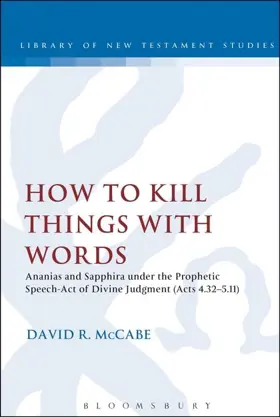

How to Kill Things with Words: Ananias and Sapphira under the Prophetic Speech-Act of Divine Judgment (Acts 4.32-5.11)
in Library of New Testament Studies
Pages
296
Publisher
T&T Clark
Published
12/29/2011
ISBN-13
9780567525437
This work studies the literary and socio-discursive contexts of 'the Ananias and Sapphira episode' in Acts as a narrative illustrating the negative-ethos of community goods. This work examines the dynamics of the Ananias and Sapphira episode in Acts and its role in the narrative of Luke-Acts . McCabe locates the passage within its literary context, and emphasizes the manner in which it is embedded in a discourse on the life of the Christian community expressed through shared goods. Utilizing Speech-Act Theory , McCabe argues that Peter's words, divinely sanctioned, directly execute the divine judgment upon the couple. This is argued by appealing to the social processes and conventions of language-use within the context of a 'community-of-goods' discourse as present in the Lukan narrative. McCabe appeals to the conventions deployed in the narrative world of Luke-Acts which undergird the efficacy of prophetic speech to effect divine judgment, including the patterns established by prophetic figures in the Scriptures of Israel and Luke's own characterization of Jesus as Prophet-King, followed by an examination of Luke's characterization of Peter as an apostolic-prophetic successor to Jesus, deputized to speak on behalf of God. McCabe concludes by examining the successful execution of the speech-act of divine judgment. This is formerly the Journal for the Study of the New Testament Supplement , a book series that explores the many aspects of New Testament study including historical perspectives, social-scientific and literary theory, and theological, cultural and contextual approaches. The Early Christianity in Context series, a part of JSNTS , examines the birth and development of early Christianity up to the end of the third century CE. The series places Christianity in its social, cultural, political and economic context. European Seminar on Christian Origins and Journal for the Study of the Historical Jesus Supplement are also part of JSNTS .
- Table of contents
- Acknowledgments
- 1. Introduction: Reopening the Case of Ananias and Sapphira
- 2. Ananias and Sapphira as an Episode in the Narrative of Acts
- 3. Introducing Prophetic Speech-Acts
- 4. Socio-Historical Repertoire I: The Jerusalem Church
- 5. Socio-Historical Repertoire II: Pagan and Jewish Examples
- 6. Inscribed Conventions: Divine Deputation and the Pattern of Salvation and Judgment
- 7. Legitimate Authority: Apostolic-Prophetic Succession and the Characterization of Peter
- 8. Successful Execution: Ananias and Sapphira Under the Speech-Act of Divine Judgment
- 9. Conclusion
- Bibliography